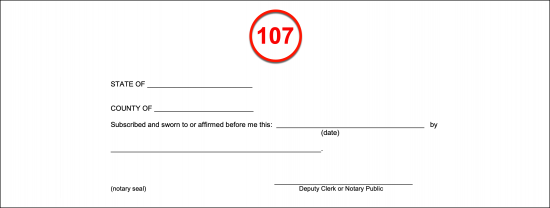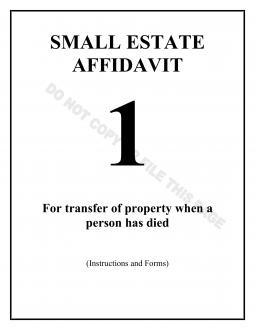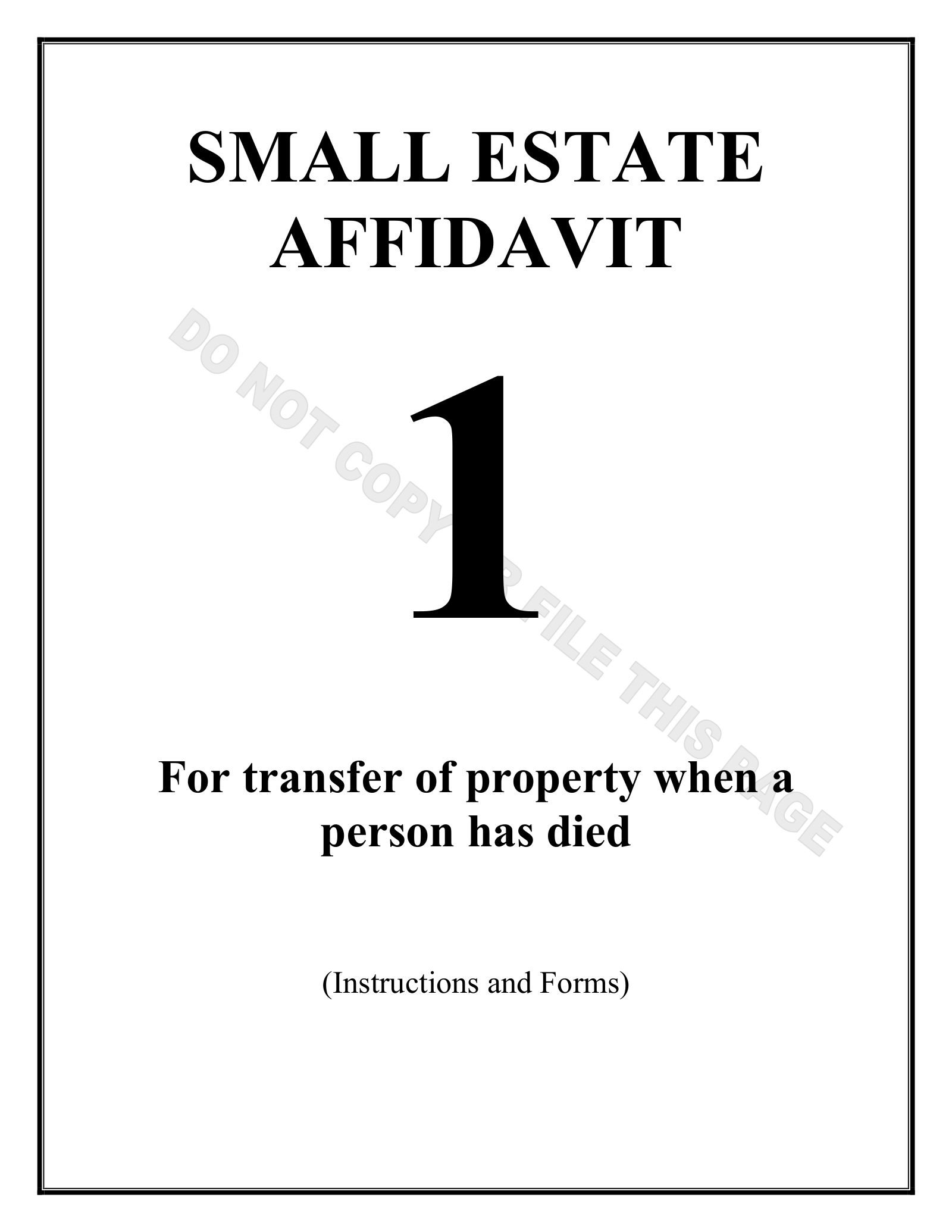Updated April 29, 2024
An Arizona small estate affidavit is a legal document that can be used to transfer assets from the estate of the decedent without going through the probate process. Avoiding probate generally means the transfer happens more quickly, but this option is only available for estates with a total value less than the maximum amount decreed by the state. For estates that qualify, a small estate affidavit is an option whether or not the decedent had a will.
Laws
- Days After Death – In Arizona, unlike some other states, the period of time that must pass before filing depends on the type of asset sought. For personal property, that is, anything but land or real estate (real property), at least thirty (30) days must have passed since the death of the decedent.[1] For real property, which includes land, and permanent structures or fixtures built on that land, at least six (6) months must have passed since the death of the decedent.[2]
- Maximum Amount ($) – As with the time that must pass after the decedent’s death, the maximum amount eligible for a small estate affidavit also varies with the type of property involved. The collected personal property in the estate may be worth no more than $75,000,[3] while the total value of all real property may be no more than $100,000.[4] For both types of property, liens and encumbrances may be deducted when summing the total.
- Signing – The form should be notarized.
- Statutes – A.R.S. § 14-3971 (Collection of Personal Property by Affidavit)
How to File (4 steps)
2. Make an Inventory
3. Determine Distribution
4. Fill Out Form
Video
How to Write
Download: PDF
(1) Person Filing. Produce your full name at the top of this page to identify yourself as the Filer of this document.
(2) Address. Furnish your full address to the two lines available below your name.
(3) Your Telephone Number.
(4) Your Email Address.
(5) Lawyer’s Bar Number. If you are an Attorney working on behalf of the Affiant through this filing, then your bar number must be furnished for proper identification.
(6) Licensed Fiduciary Number. If you are a Fiduciary Agent then record your fiduciary number where requested
(7) Filer Status. This paperwork can be filed by one of several types of Parties. Indicate whether you are representing yourself without a Lawyer, an Attorney representing the Petitioner, as the Petitioner, or as a Respondent by selecting the appropriate checkbox.
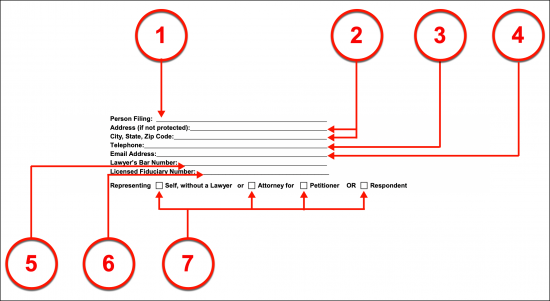
Section 1. Information About The Deceased
(8) County. The County where this paperwork is filed should be produced to the top of the page. This issue may need to be handled by the Notary Public in attendance of the signing. Seek instruction from this Party before executing this document.

(9) Name Of Person Who Died. Dispense the entire name of the Arizona Decedent to Section 1.
(10) Date Of Death. The death certificate of the Arizona Decedent will have the official date of death. This calendar date should be presented.
(11) Place Of Death. Consult the Arizona Decedent’s death certificate then document the noted place of his or her death.
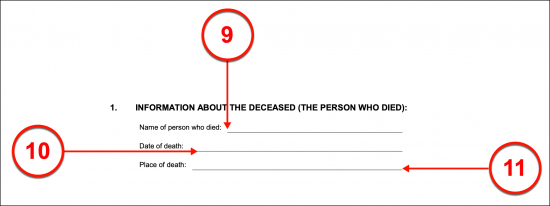
Section 3 Relationship
(12) Relationship To Arizona Decedent. Declare your relationship to the Arizona Decedent in Section 3.

Section 6. Entitlement
(13) Named In The Will. The Affiant making this petition must establish the right to succession so that he or she can control the Arizona Decedent’s estate (i.e. property that is both tangible and intangible). If the Affiant (or Petitioner) is named in the will of the Arizona Decedent to receive control of the estate, then the first checkbox statement of Section 6 should be marked. If this is not the case, then do not select this statement.

(14) No Will Made. If the Arizona Decedent did not have a will then locate the second checkbox statement for selection.
(15) Affiant Status. Once it has been established that the Arizona Decedent did not have a will, one of the checkboxes defining the Affiant relationship to the Decedent must be selected. In this way, the Affiant can be defined as the Spouse, Child, Parent, Sibling, or Sole Heir to the Decedent.
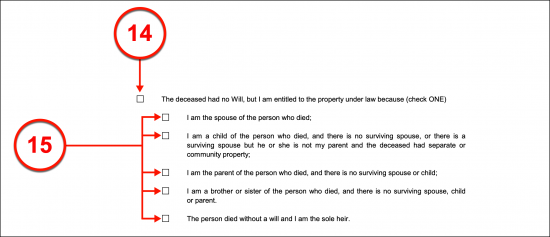
(16) Assigned Interest By Rightful Survivors. If the Arizona Decedent did not have a will but the Affiant is not the Party with the greatest level of entitlement to the concerned estate, then he or she may only present this form with the proven approval of those with a stronger right to claim the Decedent’s property. If this is the case and such paperwork has been obtained then select the second to last statement made in Section 6 and attach the signed and notarized statements (affidavits) of the Rightful Heirs.

(17) Rightful Survivors Sign Over Rights In Will. If the Arizona Decedent did have a will but the Affiant has obtained the right to claim the estate with a written release of interest from every Rightful Heir named then, select the final checkbox in Section 6.

(18) Delivered Interests To Affiant. Select the final option if the Arizona Decedent’s Heirs (named in his or her will) have given up their rights to claim property left to them in the will to the Affiant. This requires a formal written release from the Arizona Decedent’s Heirs to be attached to this document.

Section 7 Description Of Property
(19) Description. Section 7 is where every piece of personal property owned by the Arizona Decedent must be documented. This must be a complete list of all personal property owned by the Decedent and should not include real estate owned by the Arizona Decedent. There will be a different form for real estate. Be aware that late least thirty days must have passed since the Decedent passed away and that the Arizona Decedent’s personal property must be worth less than $75,000 at the time of death in order for his or her estate to be considered a small estate.
(20) Value. The monetary worth of each piece of the Arizona Decedent’s property listed in the previous area must be assessed then recorded.
(21) Location, Or Who Has Property Now. Produce the physical location of the Decedent’s personal property. If the property was not in the possession of the Arizona Decedent, then the full name and contact information of the current Holder of the Arizona Decedent’s property must be provided.
(22) Total Value. Produce the dollar sum of values entered for the Arizona Decedent’s listed personal property.
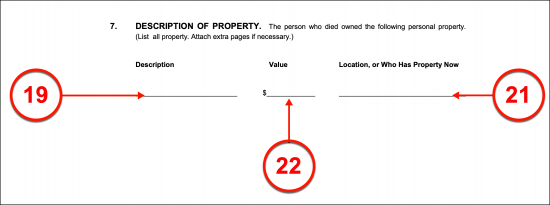
Section 8. Money Owed
(22) Description. Section 8 will discuss all debts the Arizona Decedent was qualified to collect when he or she experienced death. List every debt owed to the Arizona Decedent where requested.
(23) Amount Owed. Report the amount of money owed for the debt reported.
(24) Name Of Who Owes The Debt. Produce the full name and the current address and (if possible) phone number of the Debtor owing the defined amount for the debt reported.
(25) Total Amount Owed. Add all the amounts that are owed to the Arizona Precedent then dispense the sum at the end of this section
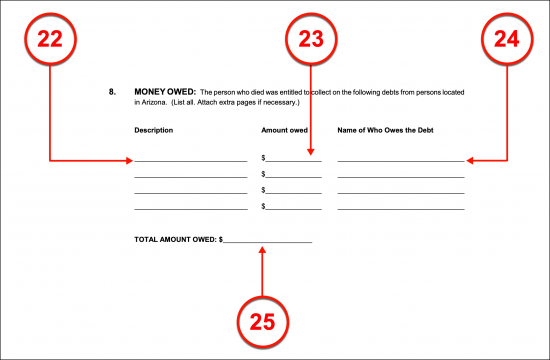
Oath Or Affirmation
(26) Signature Of Person Making Affidavit. The Party submitting this paperwork with the intention of gaining the listed Arizona Decedent estate (personal) property must sign his or her name as a licensed Notary Public (recognized by the State of Arizona) observes.
(27) Printed Name. Once the act of signing has been completed, the Affiant’s printed name must be submitted.
(28) Signature Date. The Petitioner behind this document must date the signature he or she has provided. This should be presented immediately upon signing as the current calendar date at the time. The Notary Public overseeing this process will verify this date as well as the signature provided once this document is released to him or her.
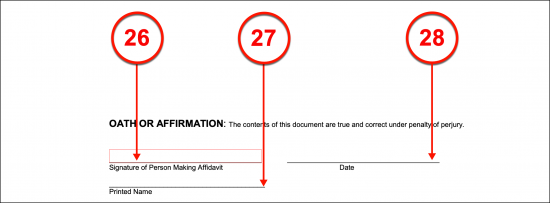
Notarization
(29) Arizona Notarization. An Arizona Notary Public will be able to verify that he or she has attended and witnessed the Affiant signing of this petition. This testimony will be provided through the notarization process he or she will complete to the area directly below the Affiant’s signature.
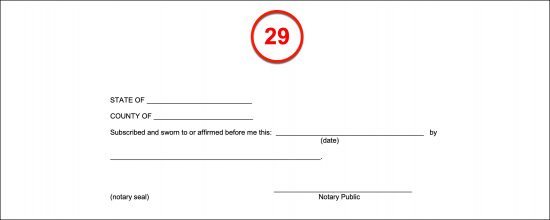
Probate Cover Sheet
(30) County. The Arizona County where this issue is filed should be displayed at the top of the page.
(31) Case Number. The case number assigned to the Arizona Decedent’s estate should be produced.

(32) Wards, Decedents, Trusts, Or Individuals. The full name of every Party involved with this matter, whether it is a rightful Heir, Survivor, Ward (of the Decedent), Minor, Dependent, or Trust should be documented.
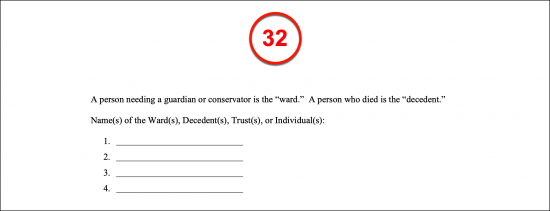
(33) Petitioner For Arizona Decedent Real Property. The full name, address, telephone number, and email of the Party filing this document should be reported where it is requested to properly introduce this page.

(34) Petitioner Status. If the Petitioner is not represented by an Attorney, then select the appropriate checkbox to present this fact. If however, an Attorney will represent the Petitioner(s) in gaining the Arizona Decedent’s real property, then leave this checkbox unmarked.

(35) Lawyer Information. If the Petitioner(s) named above will be represented by an Attorney when seeking the Arizona Decedent’s real property, then some additional information must be presented. Make sure to list this Attorney’s name, contact information (“Telephone” and “Email”) as well as his or her “Bar #” to the appropriate areas of this document.

(36) Interpreter. Select the checkbox corresponding to the Interpreter statement if anyone producing this document or receiving this document requires a formal interpretation of its content. If this checkbox is selected, produce the name of each Party who requires the Interpreter’s services.

(37) Case Number. Confirm the case number assigned to the Decedent’s estate.

(38) 200 Estate. A checklist of topics with their appropriate State Codes has been supplied to review. Each topic that applies to this paperwork must be selected. Thus locate “200 Estate.” Indicate if this is a formal or informal appointment of a Personal Representative (for the Decedent’s real property), whether this paperwork is submitted purely for administrative purposes (i.e. ancillary, trust ), whether this is formal or informal probate of the Decedent’s Will or some “Other” action which must be documented as requested by marking the appropriate checkbox. More than one checkbox may be selected so long as it accurately defines a subject matter relevant to this petition.
(39) 220 Conservator. If a Minor or an Adult (Dependent/Incapacitated) Person is involved, responsible, at the center, or related to this petition, then select the appropriate checkbox from “220 Conservator.” More than one of these statements may be selected if needed.
(40) 230 Guardianship. If this document involves the “Guardianship” of a “Minor” or Adult who is incapacitated with an advanced condition (i.e. dementia) or an Adult that requires inpatient psychiatric treatment then select the appropriate code and definition from Section “230 Guardianship.”
(41) 240 Guardianship-Conservator Combination. If this petition will concern a “Guardianship-Conservator” combination where at least one Party involved can be considered a Minor or severely debilitated Adult who requires representation then locate and use Section 240’s choices to establish this fact.
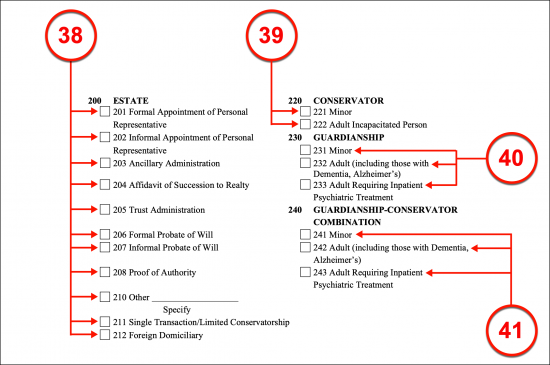
(42) Today’s Date. The Petitioner(s) or Petitioner’s Attorney must dispense a notarized signature to this document once it has been completed. This process begins with a report of the current date.
(43) Signature Of Petitioner Or Petitioner’s Attorney. The Petitioner behind this form or the Attorney representing the Petitioner(s) must sign his or her name as soon as the current calendar date is reported.

Probate Information Form For Decedent’s Estate
(44) Filer Information. The name, mailing address, current phone number(s), and email address identifying the Filer of this paperwork with his or her contact information should be delivered to the top of this form.
(45) Filer’s Attorney Information. If an Attorney represents the Affiant seeking the Arizona Decedent’s real property, then his or her bar number must be recorded.
(46) Fidicuary Information. If a Fiduciary Agent is completing this document, then his or her fiduciary licensed number should be documented.
(47) Affiant Status. The Filer must indicate if he or she is working without an Attorney on this document or if this paperwork is being completed by the Affiant’s Attorney. To this end, the Filer must select the “Self” or the “Attorney” checkbox. If the Filer is an Attorney, then the name of the Affiant must be presented.
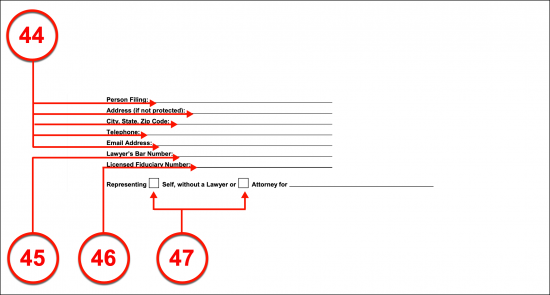
(48) Arizona County Of Action.
(49) State Generated Case Number.
(50) Arizona Decedent Name.
(51) Update Status. If a previous account has been submitted and this document is meant to update or correct previous information regarding the Petitioner, Survivors, or Arizona Decedent, then this paperwork must be presented as such. To do so, select the “Updated” checkbox. If this is not a correction or update, then leave this checkbox unmarked
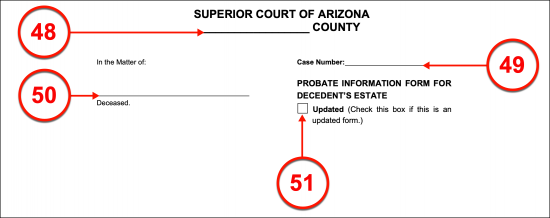
(52) Case Number.

A. Nominated Personal Representative/Special Administrator.
(53) Name. Produce the full name of the Decedent’s Personal Representative or Special Administrator.
(54) Licensing Status. Indicate if the Representative is a licensed Fiduciary by selecting the checkbox labeled “Yes.” Otherwise, select the “No” box. Furthermore, If the Representative being identified is a Licensed Fiduciary then provide his or her license information to the area requesting it.
(55) Mailing And Physical Address. If the Representative has a mailing address that is separate from his or her physical address, then both must be recorded. Produce the mailing address and/or physical address of the Representative as requested.
(56) Contact Information. Complete this area with the Representative’s phone number at work as well as his or her email address.
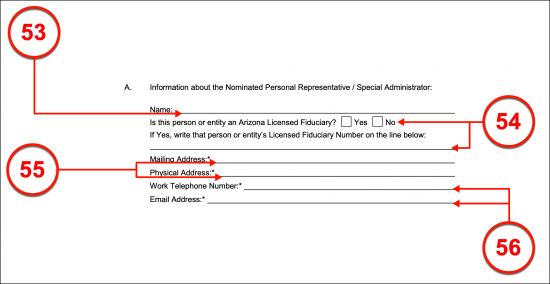
(57) Non-Fiduciary Representative Information. If the Representative is not a Licensed Fiduciary then several additional pieces of information should be recorded. An area to receive the Representative’s home and cell telephone numbers, birth date, social security number, race, height, weight, eye and hair color, and sex has been supplied. This information is considered confidential and will only be privy to the Courts of Arizona and does not need to be dispensed to additional Parties.
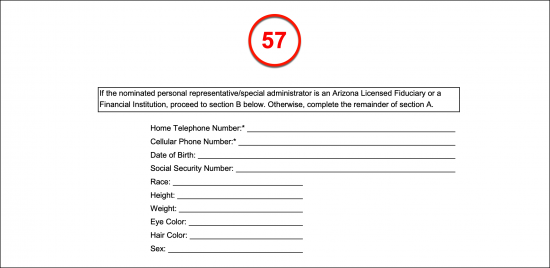
B. Information About The Decedent
(58) Name. The Arizona Decedent this document concerns must be named.
(59) Arizona Decedent Date Of Birth.
(60) Date Of Death. Transcribe the Arizona Decedent’s formal calendar date of death to Section B
(62) Arizona Decedent Social Security Number. Produce all digits making up the Arizona Decedent’s social security number.
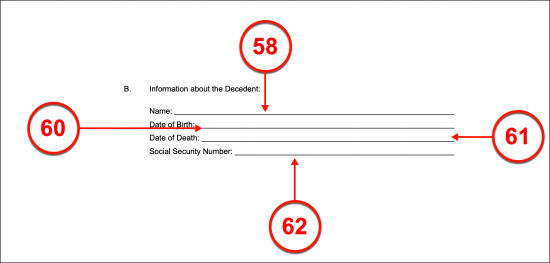
(63) Declaration. Furnish your name to the declaration statement made.
(64) Printed Name. Print your name before executing your signature.
(65) Signature. Sign your name to declare the content of this paperwork is as accurate as possible.
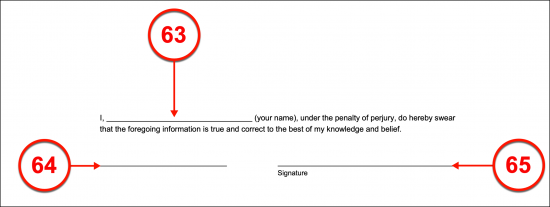
Affidavit For Transfer Of Title To Real Property Checklist
(66) Person Filing. The Individual submitting this document must self-identify at the beginning of this declaration.
(67) Contact Information Of Filer. The address, telephone number, and email address where the Filer of this affidavit can be contacted must be furnished with the Filer’s identity.
(68) Lawyer’s Bar Number. If the Filer is an Attorney, then his or her bar number must be included with his or her information above.
(69) Licensed Fiduciary Number. If a Licensed Fiduciary is involved, his or her complete license number is required.
(70) Filer Status. The Filer must declare whether he or she is a Private Party acting in his or her own interests, an Attorney representing the Affiant, or an Agent of the Affiant.
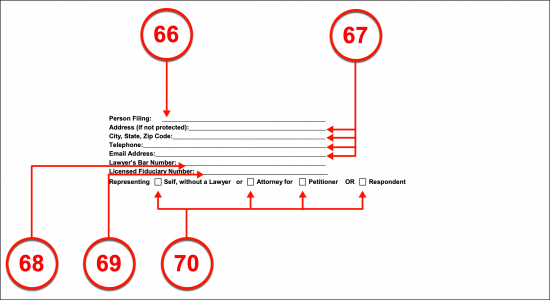
(71) Arizona County.
(72) Case Number.
(73) Matter Of Estate. Produce the full name of the Arizona Decedent on the left side of the page then indicate if he or she is an Adult or Minor by selecting the appropriate checkbox.
(74) Arizona County.
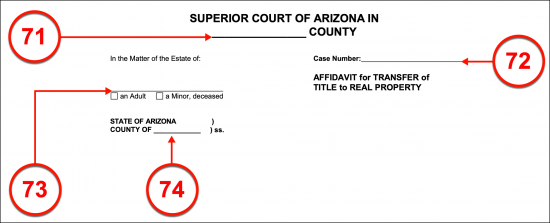
(75) Single Or Multiple Petitioners. The acknowledgment introducing the sections will require that the Affiant be defined as a single Party by marking the first checkbox or as multiple (Signature) Parties by selecting the second checkbox.

1. Information About Person Who Died
(76) Deceased. Furnish the full name of the Arizona Decedent with the date that he or she passed away on (as reported on his or her death certificate). Each of these items will have a place reserved for its presentation.
(77) Date Of Death.

2. Place Of Death
(78) Arizona Decedent’s Real Property. Select the first statement if the Decedent died in the same property being discussed then reproduce the name of this county or select the second statement to indicate the Arizona Decedent was living in a different County when he or she died then supply the city and state of this defining this second County.

3. Relationship
(79) Affiant(s)/Decedent Relationship. Define The Relationship To The Arizona Decedent. Select “My” or “Our” to indicate if one or more Affiants are submitting this document then discuss the nature of each Affiant’s relationship to the Arizona Decedent.

(80) Case No.

4. Description Of Real Property
(81) Legal Description. Locate the deed to the Arizona Decedent’s property then reproduce the legal description of the property to Section 4. In most cases, you can obtain a copy of the deed from the County Recorder’s Office where the property is located.

5. Interest Of Person Who Died In Property
(82) Decent Property Ownership. Define how the Arizona Decedent owned the property (i.e. did he or she hold a deed of ownership and if so, what kind of deed) as well as whether he or she was partial owner of the real property or only had a claim to real property.

Section 10. Reason For Real Property Entitlement
(83) Number Of Entitled Petitioners. Begin Section 10 by selecting the first or second checkbox from the “Reason…” statement. The first should be selected if only one Affiant is completing this paperwork while the second checkbox (“We Are”) should be selected if more than one Affiant is involved. Once this is done it will be time to define the Affiant’s status to the Arizona Decedent’s estate and (if relevant) last will and testament by selecting the appropriate definition(s) from the list below.

(84) Petitioning Spouse. Select the first checkbox statement in Section 10 if the Affiant is the Spouse of the Arizona Decedent and can claim the concerned real property of the estate through A.R.S. §§ 14-2401 through 14-2405.

(85) Petitioning Surviving Minor/Dependent. Select the second statement’s checkbox if the Affiant is a Minor or Dependent of the Arizona Decedent, has written statements from the Arizona Decedent’s other Dependents that release their interest in the real property to the Affiant, and the Decedent was unmarried or had no Spouse at the time of his or her death.
(86) Greatest Interest Surviving Minor/Dependents. Select the third checkbox if there is more than one Affiant and these Petitioners have the strongest claim on the Arizona Decedent’s real property because the Arizona Decedent had no Spouse and no other Dependent holds a greater right to the property than the Affiants behind this paperwork.

(87) Named In Will. If the Affiant(s) is named in the Arizona Decedent’s will then locate the fourth checkbox statement in Section 10 and select it. Notice this statement contains two checkboxes within it. Select the first if only one Affiant is filing this document or the second if there are more than one Affiants. Once done, document the name of the Arizona Decedent as well as the name of the Arizona Court handling this case then the case number assigned to it.

(88) Case Number. The top of the next page must display the case number for this matter.

(89) Arizona Decedent With No Will. If the Arizona Decedent did not have a will in place then mark the checkbox corresponding to the statement “The Person Who Died Had No Will…” This will require an additional description of the Affiant(s)
(90) Status Of Entitled Spouse Of No-Will Decedent. Select the first statement from the list of options provided If the Arizona Decedent did not have a will and the Affiant is his or her Spouse.
(91) Children Of No Will Arizona Decedent. If the Affiant is the Child of the Arizona Decedent, and the Arizona Decedent had no spouse or the concerned property is not considered the property of the Spouse then choose the second statement in this list.
(92) Sole Heir Of No-Will Arizona Decedent. If the Affiant is the Arizona Decedent’s Parent and the only Survivor to the Decedent, then mark the checkbox corresponding to the fourth statement.
(93) Greater Or Equal Right Relinquishment. Choose the final statement’s checkbox if the Affiant is the Sibling (Brother or Sister) of the Arizona Decedent and has the greatest right to his or her real property because there is no closer Survivor ( Spouse, Child, Parent).
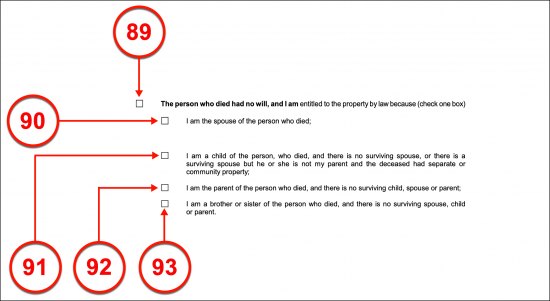
(94) No Surviving Spouse. Select the appropriate statement’s check box to indicate that the Arizona Decedent passed away without a Spouse who owned the real property communally.
(95) Surviving Children Of Affiant. The first checkbox in this section should be selected if the Children of the Arizona Decedent are the Affiant(s) behind this document and no Spouse of the Arizona Decedent has as powerful a claim to the estate property.
(96) Arizona Decedent Siblings. If the Affiant is the Sibling of the Arizona Decedent and his or her claim to the estate’s real property is greater than the Decedent’s Spouse (because the Decedent was the sole owner) or the Decedent had no Spouse and no will, then select the second statement in this area.
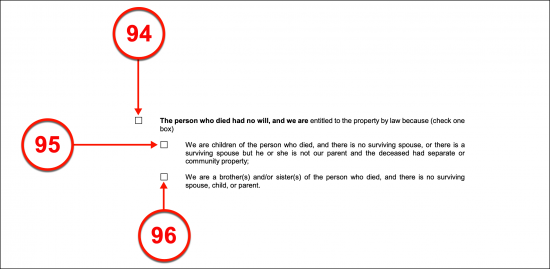
(97) Affiant As Sole Heir. If the Arizona Decedent did not have a will but the Affiant is the Sole Heir to the estate, then place a mark in the appropriate checkbox and continue through this declaration by selecting “I Am” if only a single Affiant is involved or “We Are” if more than one Affiant is involved.
(98) Release From Greater Or Equal Right Heirs. If the Affiant is not the Sole Heir and the Decedent has not made a will but all other Heirs have released their interest in the Arizona Decedent’s real property through a written (and attached) statement then the eighth major statement definition must be selected
(99) Affidavit Release For Real Property. Select the ninth definition if there is more than one Affiant behind this document, none of the Affiants are sole Heirs, and every other Heir has provided an affidavit releasing their interests to the Affiants behind this paperwork. This selection should only be chosen if the Arizona Decedent did not have a will.
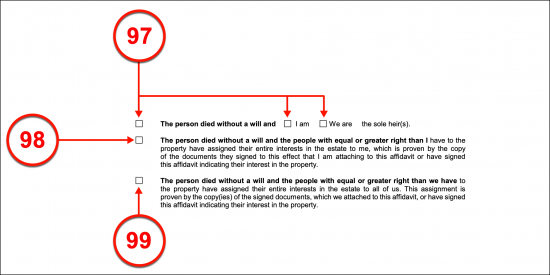
(100) Named As Heir To Estate In Will. Select the appropriate checkbox to indicate if the Affiant is the Sole Heir to the real property of the Arizona Decedent because he or she has been named as such in the Decedent’s will.
(101) Release Of Property From Those Named In Will. If the Arizona Decedent has named Heirs as the rightful receivers of the real property but each such Heir has provided a release of his or her interest in this property to the Affiant, then choose the second to last statement made.
(102) Formal Release From Those Named In Will. If the Affiant has gained formal affidavits from Heirs named in the Arizona Decedent’s will as the inheritors of real property that release all such interests in this property to the Affiant, then select the final statement.
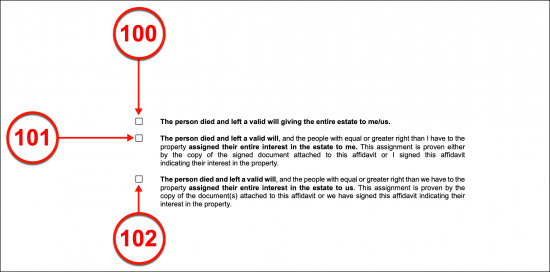
(103) Case Number.

(104) Signature Of Person Making Affidavit. The Affiant petitioning for the real property of the Arizona Decedent must sign his or her name. If there are more than one Affiants, each must provide a notarized signature. There will be a few additional areas for this purpose.
(105) Printed Name Of Person. After signing this document the Affiant should print his or her name.
(106) Date. The calendar date when the Affiant supplies his or her signature must be documented as soon as this document is signed.

(107) Notary Public Action. This paperwork requires an Arizona-recognized Notary Public to observe the signature process. Once the Affiants have provided his or her signature, the Notary will complete the area that follows to authenticate his or her signature.
